Marine snow is formed by organisms that live near the ocean's surface and are not consumed by their predators when they die.

The snow we all know falls when it's cold and covers the streets in white every year at this time. However, there is a not Christmas snow, less white and unknown to many people: ‘marine snow’, which sinks from upper waters to the deep ocean as organisms living near the ocean’s surface die and are not consumed by their predators.
This snow falls on the seabed in the same way leaves do in a forest. In the sea, a good example would be algae, sessile organisms that live attached to the substrate. When they die, if there are no organisms that feed on them, they are gradually degraded and end up creating a shower of organic particles of different sizes that fall away.
Finally, organisms' waste particles such as fecal pellets and different inorganic particles, including sand and silt, are also part of this shower of particles. All this decomposing material is known as ‘marine snow’ because it resembles fluffy white threads reminiscent of snowflakes or particulate matter aggregates.
These flakes or aggregates change as they fall and can take weeks to reach the seabed. However, as they sink they provide food for a wide variety of organisms that either filter this ‘marine snow’ from the water or feed on it when it is deposited on the bottom.
A source of food for many organisms
The organisms that feed on ‘marine snow’ are filter feeders, and sometimes have associated microorganisms that absorb organic particles as if they were a vacuum cleaner. This feeding strategy occurs in several zooplankton species such as copepods, krill or claws.
When ‘marine snow’ is close enough to the seabed, it is used by organisms with the same trophic strategy but which are sessile, that is, which cannot move, such as sponges, gorgonians or some molluscs, as well as by others that move on the sediment surface, such as polychaetes. Apart from feeding on the ‘marine snow’ particles, many of these organisms are capable of transforming them into substances that increase their nutritional content.
Many of the substances that make up ‘marine snow’, such as dissolved organic matter or some proteins and amino acids, act as a kind of glue by encouraging other particles to stick on them, which gives rise to larger snowflakes that end up forming the substrate where microorganisms such as bacteria, protozoa or microalgae live and feed.
If ‘marine snow’ takes a long time to reach the sediment or the deep-water layers, it ends up losing its immediate nutritional power and when it is deposited on the seabed it becomes part of the food on which decomposing organisms capable of taking advantage of this refractory material feed.
These organisms integrate marine microbial trophic chains where, for example, bacteria play an important role in decomposing and remineralizing particles that no longer serve as food for other organisms. This is the case of chitin in the exoskeleton of crustaceans or cellulose from marine plants, which once decomposed, are once again available to filter feeders.
In the ocean, it is been snowing this way for more than 600 million years, when in the early Cambrian the Earth experienced an explosion of diversity dominated by filter feeders. This shows that the suspended material that forms ‘marine snow’ had already been forming in the water column for hundreds of years.
Since then, the less Christmas-like snow we know has been playing a key role in the proliferation and evolution of a large number of filter feeders, both benthic and planktonic and has contributed to the development of a diverse and very abundant microbial life in all ocean ecosystems, from coastal to open ocean and deeper.